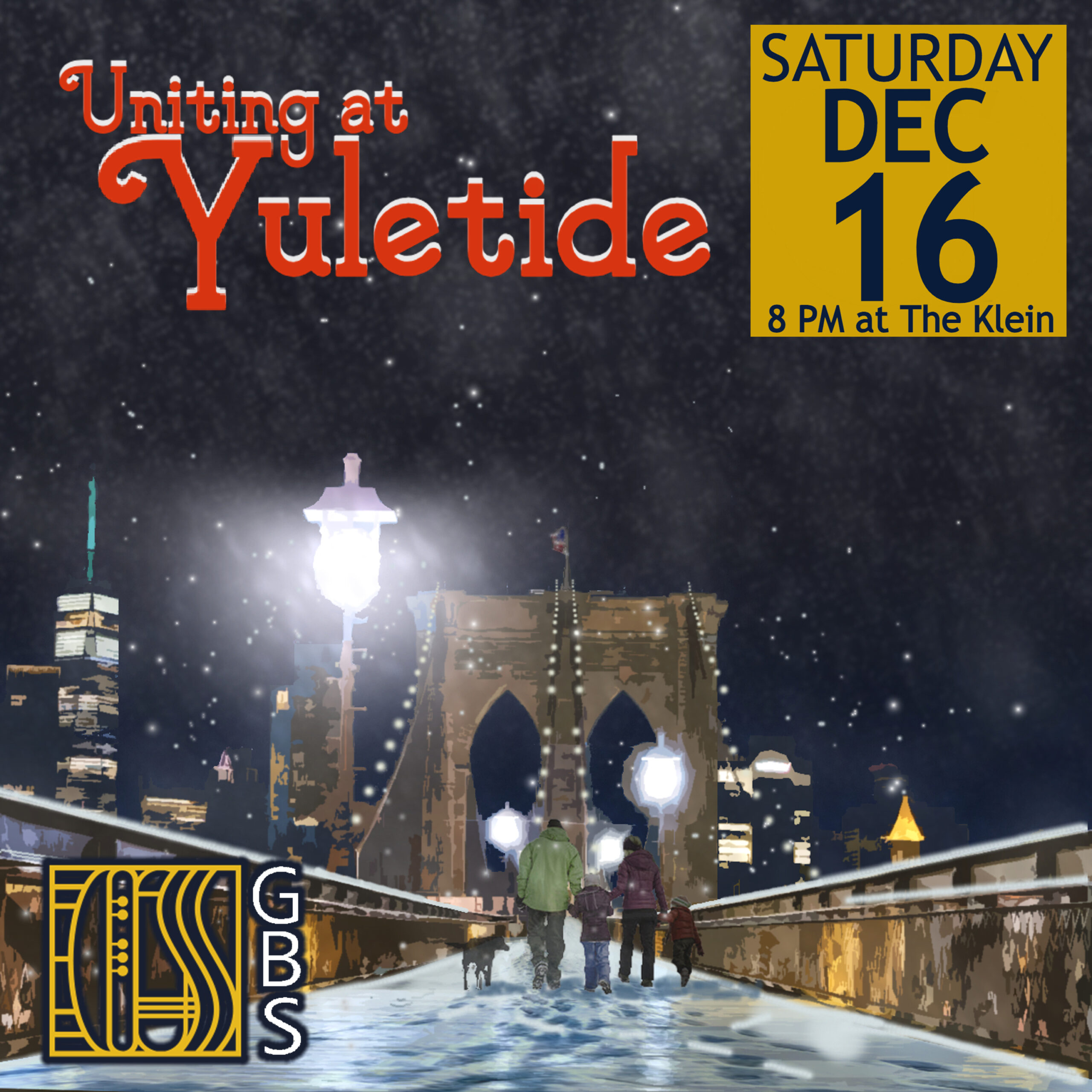
- This event has passed.
Uniting at Yuletide
December 16, 2023 @ 8:00 pm

A holiday festival! Singalongs, music of the masters, and carols — bring the family!
(PROGRAM NOTES BELOW)
Eduardo Leandro, Conductor
-The Doris and Herbert Harrington Pre-Concert Talk-
A special presentation from GBS about next season
-Maureen Hamill and friends will sing and lead some singalong pieces!
Jule Styne Let It Snow! Let It Snow! Let It Snow! (1945)
Traditional Away in a Manger
Johann Strauss II The Blue Danube (1866)
(1825-1899) Op. 314
John Williams Harry Potter and the Sorcerer’s Stone (2001)
(b. 1932)
Mykola Leontovich Carol of the Bells (1914)
(1877-1921)
J. S. Bach Jesu Joy of Man’s Desiring (1723)
(1685-1750) BWV 147
Traditional Chanukah Festival Overture, Arr. Custer/O’Loughlin
Irving Berlin White Christmas (1942)
(1888-1989)
Leroy Anderson Sleigh Ride (1948)
(1825-1899)
I N T E R M I S S I O N
Traditional O Come All Ye Faithful (1744)
Pyotr Ilych Tchaikovsky Waltz of the Flowers (1892)
(1840-1893) Op. 71a (from The Nutcracker Suite)
Georges Bizet Farandole from L’Arlesienne (1885-86)
(1838-1875)
Traditional Hark the Herald Angels Sing (1739)
Isaac Watts Joy to the World (1719)
Franz Gruber Silent Night (1818)
_________________________________________
PROGRAM NOTES
December 16, 2023
UNITING AT YULETIDE
Music forms a giant part of our experiences and memories in the holiday season, and this program draws from the many streams of music that form our holiday memories. Folk, composed “classical” music, film music, and the Great American Songbook all contribute to this mighty river, and this evening’s program. Many might be surprised at how orchestral music forms a vital part of the soundtrack of our lives, but this evening’s program demonstrates this.
From the folk tradition, the relatively minor Jewish holiday of Hanukkah has nevertheless spawned a small but beloved repertoire of folksongs. Grammy- Award winning conductor and composer Lucas Richman has served as Music Director of the Bangor Symphony, the Knoxville Symphony, and an array of ensembles internationally as guest conductor. His Hanukkah Festival Overture sets the folk melodies that are an integral part of Hanukkah, and has been performed by hundreds of orchestras since its composition in 1994. From another part of the world, the Ukraine, what American audiences know as Carol of the Bells is actually a New Year carol, Shchedryk, written in 1914 by the Ukrainian composer Mykola Leontovych, and based on Ukranian folktunes. It received its first United States performance at Carnegie Hall in 1922, by the Ukranian National Chorus. Peter J. Wilhousky wrote the English lyrics we hear each December. Through these pieces, we remember, in our own small way, these two regions where our neighbors continue to suffer the effects of war and violence this year.
Familiar Christmas carols from Europe and the Americas might as well be folk music, but have an interesting history. The origins of the familiar American carol Away in a Manger are shrouded in mystery; the text was long attributed, incorrectly, to Martin Luther. The third verse was penned by John T. McFarland in 1892. In metrical hymnody, text and tune pairings are interchangeable, and this carol is commonly sung to two different tunes, and sometimes to a third. The most common, Muller, was composed by James R. Murray in 1887, for a children’s hymnal. This memorable tune is easily recognizable due to the stepwise descent of an octave that begins the melody, as well as the gentle dotted rhythm reminiscent of calmly rocking an infant to sleep.
William J. Kirkpatrick composed the other tune, Cradle Song, in 1895, which uses a gentle, recurring rhythm pattern to lull the infant to sleep. Rarely, this carol is sung to an adaptation of the tune Afton Water, by 19th century Kentucky composer, lawyer, and minister Jonathan E. Spilman. Interestingly, another adaptation of Spilman’s tune became the alma mater of the University of South Carolina! O Come All Ye Faithful, attributed to John Francis Wade, has roots that may go back as far as the thirteenth century. Mendelssohn and Handel contributed, indirectly, to the Christmas carol repertoire, with Hark the Herald Angels Sing and Joy to the World, created by Lowell Mason (the father of music education in American schools). Franz Gruber’s beloved Stille Nacht premiered at St. Nicholas in Orbendorf, Austria in 1818. Father Joseph Mohr wrote the lyrics in 1816, and asked Franz Gruber, teacher and organist in the neighboring town, to write the music. Mohr accompanied the premiere on guitar since the organ was damaged by flooding.
From the classical tradition, Tchaikovsky’s Nutcracker Suite and Strauss’ An der schönen blauen Donau, Op. 314, commonly known to English-speaking audiences as the Blue Danube Waltz form familiar symphonic contributions to our Christmas and New Year memories. J. S. Bach’s Jesus bleibet meine Freude is the tenth movement of his 1712 Advent church cantata Herz und Mund und Tat und Leben, BWV 147, known to English-speaking audiences as Jesu, Joy of Man’s Desiring.
The final stream of music explored this evening includes songs written during the era of, or in the style of, the Great American Songbook. Irving Berlin’s White Christmas, written for the 1942 film Holiday Inn, and Sammy Cahn and Jule Styne’s Let It Snow dates from 1945. In a similar vein, John Williams’ marvelous score for the Harry Potter films evoke the rich world of these stories, including a Christmas feast in the Great Hall of Hogwarts.
May your holiday feasts be magnificent!
Frank Martignetti, Ph.D.
Sacred Heart University
Click here then click “Subscriptions” for subscriptions at deep discounts.